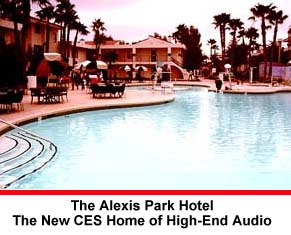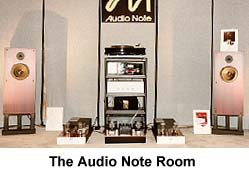
John Upton

February 1997
In reflecting on my experience at the Consumer Electronics Show, and perhaps as an inevitable reaction to hanging out with a pack of Canadians, I keep thinking back to a telling scene from the movie Strange Brew. Bob McKenzie had just been captured by the evil Brewmeister Smith and was thrown into a sealed vat rapidly filling with beer. Our hero, at first delighted with this development, soon came to the realization that it is possible to have too much of a good thing. When faced with the dizzying array of high end, mid-fi, and home theater exhibitors and exhibitions at the Show, I experienced a similar dilemma. Nevertheless, like Bob, I had a triumph of sorts, but now without the aural equivalent of feeling like I had just drunk my way out of a 750 gallon beer tank.
Due to time restrictions imposed by my day job (no, I'm not about to quit it), I only had about 48 hours to take in the sights and sounds. Given this limited schedule, the crowded show conditions, and the logistical nightmares involved in evaluating equipment located in at least four different convention sites (tip #1- wear comfortable shoes, I could not fairly listen to everything. Nevertheless, with a bit of advance planning, I was able to experience a fair number of high end systems all over Las Vegas- some of which were excellent sounding, others not-so-excellent sounding, and a few that can only be described as downright awful. To the able reports prepared by my Soundstage! colleagues, I add the following thoughts and observations…
 First, it should come as no surprise to anyone that
trade-show conditions do not offer the ideal method of
demonstrating and evaluating finicky high end audio components.
For example, much of the high end audio action congregated at the
Alexis Park Hotel, the facilities of which
offered distinct advantages and disadvantages. On the positive
side, the exhibitors were well spaced throughout the hotel
grounds, minimizing those annoying spillover sounds from
neighboring exhibits. In addition, the outdoor corridors of the
demonstration complexes allowed the rooms to "breathe"
in such a way that I didn't experience the "audio
sauna" conditions, along with the corresponding "audio
odors", of other shows I've attended. On the downside,
however, I thought that the rooms at both the Alexis Park and the
rival audio show at the Debbie Reynolds Hotel were just too small
for many of the speakers demonstrated. These speaker/room
interaction problems compromised the performance of several
systems that I KNOW should have sounded a whole lot better than
they did.
First, it should come as no surprise to anyone that
trade-show conditions do not offer the ideal method of
demonstrating and evaluating finicky high end audio components.
For example, much of the high end audio action congregated at the
Alexis Park Hotel, the facilities of which
offered distinct advantages and disadvantages. On the positive
side, the exhibitors were well spaced throughout the hotel
grounds, minimizing those annoying spillover sounds from
neighboring exhibits. In addition, the outdoor corridors of the
demonstration complexes allowed the rooms to "breathe"
in such a way that I didn't experience the "audio
sauna" conditions, along with the corresponding "audio
odors", of other shows I've attended. On the downside,
however, I thought that the rooms at both the Alexis Park and the
rival audio show at the Debbie Reynolds Hotel were just too small
for many of the speakers demonstrated. These speaker/room
interaction problems compromised the performance of several
systems that I KNOW should have sounded a whole lot better than
they did.
Second, it has been my experience that listening to a high end audio show product demonstration is a lot like watching a preview trailer at a movie theater. The exhibitors, like the movie studios, are trying to pump up as much interest and excitement as they can in their product by playing carefully pre-selected source material at specific volumes best suited to strengths of the particular product. This method may adequately demonstrate the strengths of those products, but it falls far short of providing enough sonic information about the particular component to establish even a rudimentary assessment and evaluation of its overall performance. Just as I've seen many a movie whose trailer was a whole lot better than the full release, I've heard all too many audio components that "wow" you during demonstrations but annoy and disappoint on full evaluation.
While I certainly don't begrudge the typical exhibitor for trying to show his products in the best possible light, and though I am certainly willing to indulge him or her (to a certain extent) by listening to at least a few manufacturer's selections, why do they invariably insist on subjecting the listener to those same, tired audiophile warhorses? It's the same stuff almost every time. The way around this phenomenon is, of course, to politely but firmly request a few cuts from your own reference materials. Unfortunately, a mad dash to catch my flight into Vegas prevented me from heeding my own advice. I paid a terrible price for inadvertently leaving my packet of reference disks at home and suffered through countless demonstrations featuring the Holly Cole Trio, the Eagles and the dreaded Sheffield Drum Record. Recording quality be damned- if I ever hear any of these artists/disks again it will be much too soon (show tip #2- bring your own disks).
That being said, there was still much to see, hear, and enjoy during my two day assault of the best that the high end had to offer. Given the rare opportunity, I made a point of seeking out some of the lesser-known manufacturers, those featuring products of the single-ended variety in particular, to explore a few alternatives to mainstream audio thinking.
Single-ended triodes have been much in the audio news of late, and though I thought I had read enough to have a pretty good idea of what this movement is all about, I was completely taken aback by first my first brush with this comparatively ancient technology. As you may have guessed from my earlier writings, I'm a "real music" kind of guy and did NOT think that the single-ended scene, what with the wimpy power outputs and the sensitive speakers, had much to offer me. REAL men aren't all that sensitive, so why should their speakers be, right? Nevertheless, I was quite surprised to discover that one of my favorite systems at the CES sported none other than a glowing pair of 300B-type tubes. The Nirvana/Wavelength exhibit, featuring a setup consisting of Shun Mook's Bella Voce speakers, Wavelength Audio's Napoleon monoblocks and Sine preamp, Theta digital gear, and Nirvana Cabling, caught me totally off guard.
I went into this room expecting to hear some pleasantly though unnaturally warm and syrupy music of the dynamically and rhythmically challenged variety. What I got instead was one of the most uncolored, musical systems I'd ever heard. Sticking primarily with blues and rock recordings, I found the Napoleons to offer a musical expression quite unlike anything I'd heard before. Instead of maintaining a powerful vice-like grip on the music, as the solid state systems I'm most familiar with seem to do, music just seemed to flow from this setup in a relaxed yet totally compelling manner. While it may not have offered the last word as far as the bottom end is concerned, the Napoleon/Bella Voce combination had enough bass authority to establish a more than adequate foundation for most everything we threw at it. The Bella Voce speakers check in at just about 89dB/watt efficiency, but the Napoleons, despite their single digit power outputs, were able to drive them to eminently satisfactory (if not actual concert) listening levels without protest. Those with small-to-medium listening rooms (and somewhat larger bank accounts, unfortunately) looking for an ear-friendly system should definitely check this combination out.
 Amplifiers
featuring single-ended topography weren't too hard to find, and I
spent some time with several more of them during my rounds. Audio
Note amplifiers could be found in the Audio Note room (well, duh)
and the Avantgarde Acoustic room, but neither setup was able to
muster quite the magic I heard with the Wavelengths. I suspect
that much of the problem, at least for me, has to do with the
speakers. As to the Audio Note speakers, well, all I can say is
that I guess I didn't understand what they were going for . The
Avantgardes, on the other hand, while certainly dynamic, sounded
a little "shouty" with those big bass horns and may
have been a bit too much for the presentation room. I would have
loved to hear the Audio Notes with the Bella Voces or the
Avantgarde setup in a bigger room, but maybe next time…
Amplifiers
featuring single-ended topography weren't too hard to find, and I
spent some time with several more of them during my rounds. Audio
Note amplifiers could be found in the Audio Note room (well, duh)
and the Avantgarde Acoustic room, but neither setup was able to
muster quite the magic I heard with the Wavelengths. I suspect
that much of the problem, at least for me, has to do with the
speakers. As to the Audio Note speakers, well, all I can say is
that I guess I didn't understand what they were going for . The
Avantgardes, on the other hand, while certainly dynamic, sounded
a little "shouty" with those big bass horns and may
have been a bit too much for the presentation room. I would have
loved to hear the Audio Notes with the Bella Voces or the
Avantgarde setup in a bigger room, but maybe next time…
I fared better with certain other low-powered designs. The very efficient Evett & Shaw speakers, capable of pumping out an impressive 95dB/watt, sounded particularly authoritative when driven by a 300B based, push-pull stereo amplifier manufactured by a company called Canary Electronic. Also of note were the Edgarhorn System 50 speakers, looking nothing if not like a pair of an enormous, wooden meat-grinders, albeit meat-grinders capable of 105dB sensitivity. Powered by 300B, single ended amplification from Mons Audio Lab, the System 50s betrayed less of their horn-loaded colorations than I would have thought possible, sounding positively haunting on certain vocal tracks.
Based on the number of single ended systems at this year's CES, it seems as if at least a few speaker manufacturers are taking notice of the growing single ended triode movement and finally appear to be designing models with the special requirements of these amplifiers in mind. Unfortunately, as beguiling as the sound may be, the price for a full blown, single ended, 300B based system remains, for the most part, very much prohibitive. These are definitely not entry-level products.
Lest you all get the wrong impression, tubes are not the only road to audio excellence and I heard plenty of outstanding solid state offering as well. One of the more memorable demonstrations from the silicon side of the street took place in the Metaphor Acoustic Designs room at the Debbie Reynolds. Their all out assault on the state of the art in speaker design, the Metaphor 7, sounded big, deep and powerful. As Craig Schilling and I listened to a few cuts from the latest Phish CD at concert volume level, the heat generated by the Mark Levinson monoblocks, coupled with the this 90's version of 60's hippie music, virtually transported us to the live event. All that was missing was the smell of ganja in the air and hoards of hairy hippie chicks dancing spasmatically about. As high end audio goes, it just doesn't get much more fun than that.
...John Upton
jmu@soundstage.com